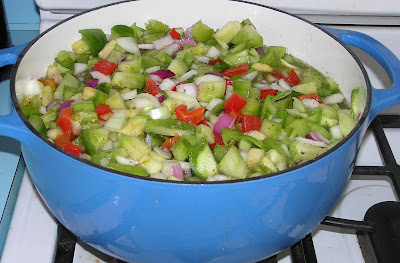 |
| Ingredients for green tomato relish are gathered on the countertop. |
It's officially the end of tomato season in Mama Bear's House. It's been a good week since the last ripe tomato from my garden.
A bit sad, really. No more fresh, sweet juicy tomatoes for roughly nine months. On the other hand, I'm a bit sick of tomatoes. And, I was most definitely sick of looking at the drooping, brown plants outside my kitchen window.
That's why I pulled them up. Oh, they were still full of green tomatoes. Even some orange ones. But, every time a fruit started blushing, a squirrel, chipmunk or slug starting munching. Or the rot set in. Plus, there really weren't any green leaves left. Clearly, it was time. Up they came.
Now, I had no trouble chucking those withered plants into the compost bin. Do you think I could throw away the fruit, though? Nope. I had a whole stock pot full of green tomatoes of all sizes. So, on a recipe hunt I went.
I settled on Sweet Green Tomato Relish from my Pickles and Relish book. The yield was far greater than expected, but it will be tasty with a burger. Maybe a taste of summer along with a winter meatloaf?
If you have a bunch of green tomatoes, and your not quite sure what to do with them, you might give this relish a try.
 |
| Relish cooking in the new blue pot that was my birthday present. |
Green Tomato Relish with Honey
from "Pickles & Relishes: From apples to zucchini, 150 recipes for preserving the harvest" by Andrea Chesman
12 green tomatoes
4 large sweet onions1 red bell pepper
1 green bell pepper
4 cups white vinegar
1 cup dark honey
1 tablespoon pickling salt
1 tablespoon mustard seed
1 tablespoon celery seed
Chop the tomatoes, onions and peppers. Add the remaining ingredients and cook for 20 minutes. Put into clean, hot pint (or smaller) jars leaving a 1/2-inch headspace. Seal. Process in a boiling water bath canner for 15 minutes.
(Adjust processing time for altitude bove 1,000 feet: 20 minutes; above 6,000 feet: 25 minutes)
Anyone have any other suggestions for using up the season's end unripe tomatoes?








